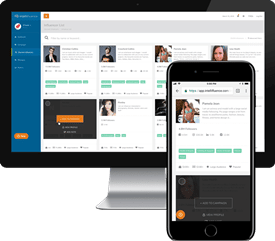Last Updated on June 8, 2020
Businesses need to tie their social media efforts to sales now more than ever. It’s not enough to just have a presence on Facebook and Twitter. Modern companies are expected to connect with customers, drive traffic to their websites, and turn audiences into sales leads. While social selling comes naturally to some brands, it’s harder for others — but not impossible. With the right resources and help from services like Intellifluence, your brand can start engaging with customers online and turn audiences into buyers.
Share Relevant Content
Social selling starts with content. The audiences you engage with on social media fall into multiple levels of your sales funnel. Some people are just now hearing about your brand (in the top awareness stage), while others want to know how your brand differs from others.
As you develop a content strategy, make sure your posts address these elements. List your various social media audiences and discuss the buyer journey, then create content that addresses their needs. Each piece of content you create and share should have measurable goals linked to the post. Do you want to increase engagement? Do you want to drive traffic to your website? Your content should solve these problems and help you achieve your marketing goals.
Communicate With Prospective Buyers
Social media is increasingly a customer service tool. Your prospective buyers use social channels to learn about your values, products, and buying experience. As part of your social selling initiatives, make sure you have the time and resources to connect with prospects and show that you can help them through the buying process.
You can do this in a few ways. Keep tabs on people who mention your brand or ask questions about your products. You can jump in and respond to these concerns as they pop-up. You can also listen for problems and issues that your customers have outside of your brand terms. This is proactive communication because you can introduce your brand to customers as a hero-product solving their problems. In both cases, social media becomes a sale platform that moves customers to your website or to a phone consultation.
Develop Branding Initiatives
The goal of social media marketing is to make your brand known across the web. As you gain traction online, make sure your brand reflects your customers, your values, and your products. Some brands create branding campaigns specifically for social media. This gives their team members the tools for maintaining the correct brand voice when they respond to customers.
Social media is full of content. If your brand is vague or confusing, then your audience is likely to forget it, ignore it, or move on to another company with a clear vision and brand goals.
Social Listening
Listening is an essential part of brand management and customer retention. Consider the fact that Spigit, a leading ideation management company, proclaims 75 percent of customers expect a response from a brand in less than five minutes. Additionally, 66 percent of customers will switch brands if they are treated like a number instead of a person, and 64 percent of B2C brands expect real-time online communication with companies. Your customers expect you to listen and respond, and they will leave if you don’t.
Social listening is social selling because you can reduce customer churn with good customer service. You can also lure new customers when they see that you respond to problems, treat people with respect, and actively take steps to remediate issues.
Social listening is also easy to track. You can measure the number of problems customers have per week or month, the average time it takes to respond and solve their issues, and the percent of customers who return or leave happy. These metrics all help your brand stay on top of its customer engagement strategies.
Tap Into Peer-Level Influencers
Social media users trust their peers more than brands and certainly more than celebrities. Research shows that only 3 percent of customers would buy a product because a celebrity endorsed it, but 30 percent of buyers would choose a product recommended by a peer or non-celebrity. This is great news for B2B brands or SMEs that can’t afford major celebrity endorsements. It’s easier and more affordable to use peer-influencers and more effective for customers.
Consider highlighting some local influencers in your area to promote your brand. Let’s say you lived in Belgium. You can use Intellifluence to find the Top Belgium Influencers to promote your product or service. Even if these people have a smaller following than their celebrity or aspirational counterparts, they can have a significant impact on your selling efforts and drive audiences to try your brand.
Intellifluence prides itself on using the latest trends and tools to make social selling easy for brands of all sizes. By identifying the best social channels for your company and identifying underutilized opportunities to grow sales, we can help you create a social media strategy that taps into the power of local influencers to communicate with audiences across the web. Social media isn’t just about broadcasting messages anymore. Strategic marketers use it to engage customers and grow their bottom line.

SallyBot is committed to helping users get the most out of Intellifluence. By helping brands create campaigns, providing unparalleled customer service and offering useful advice, nothing makes SallyBot happier than hearing she is liked… Really, really liked.






